The Capabilities of FY-3D/MERSI-II Sensor to Detect and Quantify Thermal Volcanic Activity: The 2020–2023 Mount Etna Case Study
Abstract
1. Introduction
2. Mount Etna and Case Study
Mount Etna
The 2020–2023 Volcanic Activity Case Study
3. Sensors and Methods
3.1. Fenguyn-3D and MERSI-II Sensor
3.2. MERSI-II Data Pre-Processing
3.3. MIROVA Algorithm and Volcanic Radiative Power (VRP)
3.4. Determination of α Coefficient for MERSI-II
3.5. Time Averaged Discharge Rates (TADRs) and Total Erupted Volumes
4. Results
4.1. 2020–2023 MERSI-II Evaluation
4.2. Etna November 2022–February 2023 Eruption
4.2.1. Effect of Viewing Geometry and Cloud Coverage
4.2.2. Discharge Rates and Erupted Volumes
5. Discussions and Conclusive Remarks
5.1. MERSI Sensors: Limits and Sensitivity
5.2. Advantages of a Multiplatform Approach
6. Conclusions
Author Contributions
Funding
Data Availability Statement
Acknowledgments
Conflicts of Interest
References
- Ramsey, M.; Harris, A.J.L. How will thermal remote sensing of volcanic surface activity evolve over the next decade? J. Volcanol. Geotherm. Res. 2013, 249, 217–233. [Google Scholar] [CrossRef]
- Harris, A. Thermal Remote Sensing of Active Volcanoes: A User’s Manual; Cambridge University Press: Cambridge, UK, 2013. [Google Scholar] [CrossRef]
- Blackett, M. An Overview of Infrared Remote Sensing of Volcanic Activity. J. Imaging 2017, 3, 13. [Google Scholar] [CrossRef][Green Version]
- Blackett, M. Early Analysis of Landsat-8 Thermal Infrared Sensor Imagery of Volcanic Activity. Remote Sens. 2014, 6, 2282–2295. [Google Scholar] [CrossRef][Green Version]
- Ramsey, M.S.; Flynn, L.P. Strategies, insights, and the recent advances in volcanic monitoring and mapping with data from NASA’s Earth Observing System. J. Volcanol. Geotherm. Res. 2004, 135, 1–11. [Google Scholar] [CrossRef]
- Wright, R.; Flynn, L.P.; Garbeil, H.; Harris, A.J.L.; Pilger, E. Automated volcanic eruption detection using MODIS. Remote Sens. Environ. 2002, 82, 135–155. [Google Scholar] [CrossRef][Green Version]
- Watson, I.M.; Realmuto, V.J.; Rose, W.I.; Prata, A.J.; Bluth, G.J.S.; Gu, Y.; Bader, C.E.; Yu, T. Thermal Infrared Remote Sensing of Volcanic Emissions Using the Moderate Resolution Imaging Spectroradiometer. J. Volcanol. Geotherm. Res. 2004, 135, 75–89. [Google Scholar] [CrossRef]
- Rothery, D.A.; Coppola, D.; Saunders, C. Analysis of volcanic activity patterns using MODIS thermal alerts. Bull. Volcanol. 2005, 67, 539–556. [Google Scholar] [CrossRef][Green Version]
- Coppola, D.D.; Piscopo, M.; Laiolo, C.; Cigolini, D. Delle Donne, and M. Ripepe. Radiative Heat Power at Stromboli Volcano During 2000–2011: Twelve Years of MODIS Observations. J. Volcanol. Geotherm. Res. 2012, 215, 48–60. [Google Scholar] [CrossRef][Green Version]
- Coppola, D.M.; Laiolo, C.; Cigolini, D.; Delle, D.; Ripepe, M. Enhanced Volcanic Hot-Spot Detection Using MODIS IR Data: Results from the MIROVA System. Geol. Soc. Lond. Spec. Publ. 2016, 426, 181–205. [Google Scholar] [CrossRef]
- Wright, R.; Flynn, L.P.; Garbeil, H.; Harris, A.J.L.; Pilger, E. MODVOLC: Near-real-time thermal monitoring of global volcanism. J. Volc. Geotherm. Res. 2004, 135, 29–49. [Google Scholar] [CrossRef]
- Coppola, D.; Laiolo, M.; Cigolini, C.; Massimetti, F.; Delle Donne, D.; Ripepe, M.; Arias, H.; Barsotti, S.; Parra, C.B.; Centeno, R.G.; et al. Thermal Remote Sensing for Global Volcano Monitoring: Experiences from the MIROVA System. Front. Earth Sci. 2020, 7, 362. [Google Scholar] [CrossRef][Green Version]
- Massimetti, F.; Coppola, D.; Laiolo, M.; Valade, S.; Cigolini, C.; Ripepe, M. Volcanic Hot-Spot Detection Using SENTINEL-2: A Comparison with MODIS–MIROVA Thermal Data Series. Remote Sens. 2020, 12, 820. [Google Scholar] [CrossRef][Green Version]
- Campus, A.; Laiolo, M.; Massimetti, F.; Coppola, D. The Transition from MODIS to VIIRS for Global Volcano Thermal Monitoring. Sensors 2022, 22, 1713. [Google Scholar] [CrossRef] [PubMed]
- Furtney, M.A.; Pritchard, M.E.; Biggs, J.; Carn, S.A.; Ebmeier, S.K.; Jay, J.A.; McCormick Kilbride, B.T.; Reath, K.A. Synthesizing multi-sensor, multi-satellite, multi-decadal datasets for global volcano monitoring. J. Volcanol. Geotherm. Res. 2018, 365, 38–56. [Google Scholar] [CrossRef]
- Reath, K.; Pritchard, M.; Poland, M.; Delgado, F.; Carn, S.; Coppola, D.; Andrews, B.; Ebmeier, S.K.; Rumpf, E.; Henderson, S.; et al. Thermal, deformation, and Degassing remote Sensing time Series (CE 2000–2017) at the 47 most active volcanoes in Latin AMERICA: Implications for volcanic systems. J. Geophys. Res. Solid Earth 2019, 124, 195–218. [Google Scholar] [CrossRef][Green Version]
- Girona, T.; Realmuto, V.; Lundgren, P. Large-scale thermal unrest of volcanoes for years prior to eruption. Nat. Geosci. 2021, 14, 238–241. [Google Scholar] [CrossRef]
- Laiolo, M.; Massimetti, F.; Cigolini, C.; Ripepe, M.; Coppola, D. Long-term eruptive trends from space-based thermal and SO2 emissions: A comparative analysis of Stromboli, Batu Tara and Tinakula volcanoes. Bull. Volcanol. 2018, 80, 68. [Google Scholar] [CrossRef]
- Murphy, S.W.R.; Wright, C.; Oppenheimer, C.; Souza Filho, R. MODIS and ASTER Synergy for Characterizing Thermal Volcanic Activity. Remote Sens. Environ. 2013, 131, 195–205. [Google Scholar] [CrossRef]
- Ramsey, M.S.; Harris, A.J.L.; Watson, I.M. Volcanology 2030: Will an orbital volcano observatory finally become a reality? Bull. Volcanol. 2022, 84, 6. [Google Scholar] [CrossRef]
- Harris, A.J.L.; Murray, J.B.; Aries, S.E.; Davies, M.A.; Flynn, L.P.; Wooster, M.J.; Wright, R.; Rothery, D.A. Effusion rate trends at Etna and Krafla and their implications for eruptive mechanisms. J. Volcanol. Geotherm. Res. 2000, 102, 237–270. [Google Scholar] [CrossRef]
- NC, L.; AJL, H.; JE, B.; Ripepe, M.; Calvari, S.; Dehn, J.; Rowland, S. Pulsed lava effusion at Mount Etna during 2001. J. Volcanol. Geotherm. Res. 2004, 137, 231–246. [Google Scholar]
- Bailey, J.E.; Harris, A.J.L.; Dehn, J.; Calvari, S.; Rowland, S.K. The changing morphology of an open lava channel on Mt. Etna. Bull. Volcanol. 2006, 68, 497–515. [Google Scholar] [CrossRef][Green Version]
- Calvari, S.; Bonaccorso, A.; Ganci, G. Anatomy of a Paroxysmal Lava Fountain at Etna Volcano: The Case of the 12 March 2021, Episode. Remote Sens. 2021, 13, 3052. [Google Scholar] [CrossRef]
- Aveni, S.; Blackett, M. The first evaluation of the FY-3D/MERSI-2 sensor’s thermal infrared capabilities for deriving land surface temperature in volcanic regions: A case study of Mount Etna. Int. J. Remote Sens. 2022, 43, 2777–2792. [Google Scholar] [CrossRef]
- Gouhier, M.; Harris, A.; Calvari, S.; Labazuy, P.; Guéhenneux, Y.; Donnadieu, F.; Valade, S. Lava discharge during Etna’s January 2011 fire fountain tracked using MSG-SEVIRI. Bull. Volcanol. 2012, 74, 787–793. [Google Scholar] [CrossRef]
- Corradini, S.; Guerrieri, L.; Lombardo, V.; Merucci, L.; Musacchio, M.; Prestifilippo, M.; Scollo, S.; Silvestri, M.; Spata, G.; Stelitano, D. Proximal Monitoring of the 2011–2015 Etna Lava Fountains Using MSG-SEVIRI Data. Geosciences 2018, 8, 140. [Google Scholar] [CrossRef][Green Version]
- Corradini, S.; Guerrieri, L.; Stelitano, D.; Salerno, G.; Scollo, S.; Merucci, L.; Prestifilippo, M.; Musacchio, M.; Silvestri, M.; Lombardo, V.; et al. Near Real-Time Monitoring of the Christmas 2018 Etna Eruption Using SEVIRI and Products Validation. Remote Sens. 2020, 12, 1336. [Google Scholar] [CrossRef][Green Version]
- Ganci, G.; Harris, A.J.L.; Del Negro, C.; Guehenneux, Y.; Cappello, A.; Labazuy, P.; Calvari, S.; Gouhier, M. A year of lava fountaining at Etna: Volumes from SEVIRI, Geophys. Res. Lett. 2012, 39, L06305. [Google Scholar] [CrossRef]
- Poland, M.P.; Lopez, W.; Pavolonis, M.J. Forecasting, Detecting, and Tracking Volcanic Eruptions from Space. Remote Sens. Earth Syst. Sci. 2020, 3, 55–94. [Google Scholar] [CrossRef]
- Dean, K.G.; Dehn, J.; Engle, K.; Izbekov, P.; Papp, K.; Patrick, M. Operational Satellite Monitoring of Volcanoes at the Alaska Volcano Observatory. In Monitoring Volcanic Hotspots Using Thermal Remote Sensing, Advances in Environmental Monitoring and Modelling; Harris, A.J.H., Wooster, M., Rothery, D.A., Eds.; U.S. Geological Survey Advances in Environmental Monitoring and Modelling: Reston, VA, USA, 2002; Volume 1, pp. 70–97. [Google Scholar]
- Davies, D.K.; Ilavajhala, S.; Wong, M.M.; Justice, C.O. Fire information for resource management system: Archiving and distributing modis active fire data. IEEE Trans. Geosci. Remote Sens. 2009, 47, 72–79. [Google Scholar] [CrossRef]
- Kaneko, T.; Yasuda, A.; Aoki, Y.; Kajiwara, K.; Kitagawa, S. Realtime monitoring of active volcanoes in East Asia using MODIS and MTSAT data its advancement by GCOM-C1 SGLI. Int. Arch. Photogramm. Remote Sens. Spatial Inform. Sci. 2010, 38, 209–212. [Google Scholar]
- Elvidge, C.D.; Zhizhin, M.; Hsu, F.; Baugh, K.E. VIIRS nightfire: Satellite pyrometry at night. Remote Sens. 2013, 5, 4423–4449. [Google Scholar] [CrossRef][Green Version]
- Schneider, D.J.; Randall, M.; Parker, T. Volcview: A web-based platform for satellite monitoring of volcanic activity and eruption response. In Proceedings of the Abstract ID IN41D-05 Presented at Fall Meeting 2014, San Francisco, CA, USA, 15–19 December 2014; American Geophysical Union: San Francisco, CA, USA. [Google Scholar]
- Pergola, N.; Coviello, I.; Filizzola, C.; Lacava, T.; Marchese, F.; Paciello, R.; Tramutoli, V. A review of RSTVOLC, an original algorithm for automatic detection and near-real-time monitoring of volcanic hotspots from space. Geol. Soc. Lond. Spec. Publ. 2016, 426, 55. [Google Scholar] [CrossRef]
- Gordeev, E.I.; Girina, O.A.; Lupyan, E.A.; Sorokin, A.A.; Kramareva, L.S.; Efremov, V.Y.; Kashnitskii, A.V.; Uvarov, I.A.; Burtsev, M.A.; Romanova, I.M.; et al. The volsatview information system for monitoring the volcanic activity in Kamchatka and on the Kuril Islands. J. Volcanol. Seismol. 2016, 10, 382–394. [Google Scholar] [CrossRef]
- Barnes, W.L.; Xiong, X.; Salomonson, V.V. Status of terra MODIS and aqua modis. Adv. Space Res. 2003, 32, 2099–2106. [Google Scholar] [CrossRef]
- Xiong, X.K.-F.; Chiang, A.; Wu, W.L.; Barnes, B.; Guenther, V.; Salomonson, V. Multiyear On-Orbit Calibration and Performance of Terra MODIS Thermal Emissive Bands. In IEEE Transactions on Geoscience and Remote Sensing; IEEE Xplore: Piscataway, NJ, USA, 2008; Volume 46, pp. 1790–1803. [Google Scholar] [CrossRef][Green Version]
- Xiong, X.; Butler, J.J. MODIS and VIIRS Calibration History and Future Outlook. Remote Sens. 2020, 12, 2523. [Google Scholar] [CrossRef]
- Corradino, C.; Ganci, G.; Bilotta, G.; Cappello, A.; Del Negro, C.; Fortuna, L. Infrared Remote Sensing of Volcanic Activity Using Sentinel-3 Images. Geophys. Res. Abstr. 2019, 21, EGU2019–1226–1221. [Google Scholar]
- Kaneko, T.; Yasuda, A.; Takasaki, K.; Nakano, S.; Fujii, T.; Honda, Y.; Kajiwara, K.; Murakami, H. A new infrared volcano monitoring using GCOM-C (SHIKISAI) satellite: Applications to the Asia-Pacific region. Earth Planets Space 2020, 72, 115. [Google Scholar] [CrossRef]
- Yan, L.; Hu, Y.; Li, X.; Li, J.; Zhang, Y.; Dou, C.; Plaza, J.; Plaza, A. Radiometric calibration of Fengyun-3D MERSI-II satellite: A case study in Lake Qinghai, China. In Proceedings of the GARSS 2020—2020 IEEE International Geoscience and Remote Sensing Symposium, Virtual, 26 September–2 October; IEEE: Piscataway, NJ, USA, 2020. [Google Scholar] [CrossRef]
- Du, W.; Qin, Z.; Fan, J.; Zhao, C.; Huang, Q.; Cao, K.; Abbasi, B. Land Surface Temperature Retrieval from Fengyun-3D Medium Resolution Spectral Imager II (FY-3D MERSI-II) Data with the Improved Two-Factor Split-Window Algorithm. Remote Sens. 2021, 13, 5072. [Google Scholar] [CrossRef]
- Zeng, H.; Ren, H.; Nie, J.; Zhu, J.; Ye, X.; Jiang, C. Land Surface Temperature and Emissivity Retrieval from Nighttime Middle and Thermal Infrared Images of Chinese Fengyun-3D MERSI-II. IEEE J. Sel. Top. Appl. Earth Obs. Remote Sens. 2021, 14, 7724–7733. [Google Scholar] [CrossRef]
- Dejun, Z.; Shiqi, Y.; Liang, S.; Xiaoran, L.; Shihao, T.; Hao, Z.; Qinyu, Y.; Xinyu, Z. Retrieval of land surface temperature from FY3D MERSI-II based on re-fitting Split Window Algorithm. Eur. J. Remote Sens. 2022, 55, 1–18. [Google Scholar] [CrossRef]
- Abbasi, B.; Qin, Z.; Du, W.; Fan, J.; Li, S.; Zhao, C. Spatiotemporal Variation of Land Surface Temperature Retrieved from FY-3D MERSI-II Data in Pakistan. Appl. Sci. 2022, 12, 10458. [Google Scholar] [CrossRef]
- Chen, H.; Meng, X.; Li, L.; Ni, K. Quality Assessment of FY-3D/MERSI-II Thermal Infrared Brightness Temperature Data from the Arctic Region: Application to Ice Surface Temperature Inversion. Remote Sens. 2022, 14, 6392. [Google Scholar] [CrossRef]
- Chen, J.; Yao, Q.; Chen, Z.; Li, M.; Hao, Z.; Liu, C.; Zheng, W.; Xu, M.; Chen, X.; Yang, J.; et al. The Fengyun-3D (FY-3D) global active fire product: Principle, methodology and validation. Earth Syst. Sci. Data 2022, 14, 3489–3508. [Google Scholar] [CrossRef]
- Zheng, W.; Chen, J.; Tang, S.-H.; Hu, X.-Q.; Liu, C. Fire monitoring based on FY-3D/MERSI-II far-infrared data. J. Infrared Millim. Waves 2020, 39, 120–127. [Google Scholar]
- Zheng, W.; Chen, J.; Yan, H.; Liu, C.; Tang, S.H. Global fire monitoring products of FY-3D/MERSI-II and their applications. J. Remote Sens. 2020, 24, 521–530. [Google Scholar]
- Dong, Z.; Yu, J.; An, S.; Zhang, J.; Li, J.; Xu, D. Forest Fire Detection of FY-3D Using Genetic Algorithm and Brightness Temperature Change. Forests 2022, 13, 963. [Google Scholar] [CrossRef]
- Li, J.; Ge, S.; Gao, H. FY-3D MERSI Data for Active Fire Detection Based on Improved Multi-Temporal Algorithm. In Proceedings of the IGARSS 2022—IEEE International Geoscience and Remote Sensing Symposium, Kuala Lumpur, Malaysia, 17–22 July 2022; pp. 3528–3531. [Google Scholar] [CrossRef]
- Ganci, G.; Cappello, A.; Neri, M. Data Fusion for Satellite-Derived Earth Surface: The 2021 Topographic Map of Etna Volcano. Remote Sens. 2023, 15, 198. [Google Scholar] [CrossRef]
- Bonaccorso, A.; Bonforte, A.; Calvari, S.; Del Negro, C.; Di Grazia, G.; Ganci, G.; Neri, M.; Vicari, A.; Boschi, E. The initial phases of the 2008–2009 Mount Etna eruption: A multidisciplinary approach for hazard assessment. J. Geophys. Res. 2011, 116, B03203. [Google Scholar] [CrossRef][Green Version]
- Andronico, D.; Cannata, A.; Di Grazia, G.; Ferrari, F. The 1986–2021 paroxysmal episodes at the summit craters of Mt. Etna: Insights into volcano dynamics and hazard. Earth-Sci. Rev. 2021, 220, 103686. [Google Scholar] [CrossRef]
- Bisson, M.; Spinetti, C.; Andronico, D.; Palaseanu-Lovejoy, M.; Buongiorno, M.F.; Alexandrov, O.; Cecere, T. Ten years of volcanic activity at Mt Etna: High-resolution mapping and accurate quantification of the morphological changes by Pleiades and Lidar data. Int. J. Appl. Earth Obs. Geoinf. 2021, 102, 102369. [Google Scholar] [CrossRef]
- Viccaro, M.F.; Zuccarello, A.; Cannata, P.M.; Gresta, S. How a complex basaltic volcanic system works: Constraints from integrating seismic, geodetic, and petrological data at Mount Etna volcano during the July–August 2014 eruption. J. Geophys. Res. Solid Earth 2016, 121, 5659–5678. [Google Scholar] [CrossRef][Green Version]
- Ganci, G.; Bilotta, G.; Zuccarello, F.; Calvari, S.; Cappello, A. A Multi-Sensor Satellite Approach to Characterize the Volcanic Deposits Emitted during Etna’s Lava Fountaining: The 2020–2022 Study Case. Remote Sens. 2023, 15, 916. [Google Scholar] [CrossRef]
- Del Negro, C.; Cappello, A.; Neri, M.; Bilotta, G.; Hérault, A.; Ganci, G. Lava flow hazards at Mount Etna: Constraints imposed by eruptive history and numerical simulations. Sci. Rep. 2013, 3, 3493. [Google Scholar] [CrossRef] [PubMed][Green Version]
- Ferlito, C.; Coltorti, M.; Lanzafame, G.; Giacomoni, P.P. The volatile flushing triggers eruptions at open conduit volcanoes: Evidence from Mount Etna volcano (Italy). Lithos 2014, 184, 447–455. [Google Scholar] [CrossRef]
- Moretti, R.; Métrich, N.; Arienzo, I.; Di Renzo, V.; Aiuppa, A.; Allard, P. Degassing vs. eruptive styles at Mt. Etna volcano (Sicily, Italy). Part I: Volatile stocking, gas fluxing, and the shift from low-energy to highly explosive basaltic eruptions. Chem. Geol. 2018, 482, 1–17. [Google Scholar] [CrossRef][Green Version]
- Calvari, S.; Nunnari, G. Comparison between Automated and Manual Detection of Lava Fountains from Fixed Monitoring Thermal Cameras at Etna Volcano, Italy. Remote Sens. 2022, 14, 2392. [Google Scholar] [CrossRef]
- Palaseanu-Lovejoy, M.; Bisson, M.; Spinetti, C.; Buongiorno, M.F.; Alexandrov, O.; Cecere, T. High-Resolution and Accurate Topography Reconstruction of Mount Etna from Pleiades Satellite Data. Remote Sens. 2019, 11, 2983. [Google Scholar] [CrossRef][Green Version]
- Borzi, A.M.; Giuffrida, M.; Zuccarello, F.; Palano, M.; Viccaro, M. The Christmas 2018 eruption at Mount Etna: Enlightening how the volcano factory works through a multiparametric inspection. Geochem. Geophys. Geosyst. 2020, 21, e2020GC009226. [Google Scholar] [CrossRef]
- Aloisi, M.; Jin, S.; Pulvirenti, F.; Scaltrito, A. The December 2015 Mount Etna eruption: An analysis of inflation/deflation phases and faulting processes. J. Geodyn. 2017, 107, 34–45. [Google Scholar] [CrossRef]
- Bonaccorso, A.; Calvari, S. A new approach to investigate an eruptive paroxysmal sequence using camera and strainmeter networks: Lessons from the 3–5 December 2015 activity at Etna volcano. Earth Planet. Sci. Lett. 2017, 475, 231–241. [Google Scholar] [CrossRef]
- Cannata, A.; Di Grazia, G.; Giuffrida, M.; Gresta, S.; Palano, M.; Sciotto, M.; Viccaro, M.; Zuccarello, F. Space-time evolution of magma storage and transfer at Mt. Etna volcano (Italy): The 2015–2016 reawakening of Voragine crater. Geochem. Geophys. Geosyst. 2018, 19, 471–495. [Google Scholar] [CrossRef]
- Corsaro, R.A.; Andronico, D.; Behncke, B.; Branca, S.; Caltabiano, T.; Ciancitto, F.; Cristaldi, A.; de Beni, E.; la Spina, A.; Lodato, L.; et al. Monitoring the December 2015 summit eruptions at Mt. Etna (Italy): Implications on eruptive dynamics. J. Volcanol. Geotherm. Res. 2017, 341, 53–69. [Google Scholar] [CrossRef]
- Laiolo, M.; Ripepe, M.; Cigolini, C.; Coppola, D.; Della Schiava, M.; Genco, R.; Innocenti, L.; Lacanna, G.; Marchetti, E.; Massimetti, F.; et al. Space-and Ground-Based Geophysical Data Tracking of Magma Migration in Shallow Feeding System of Mount Etna Volcano. Remote Sens. 2019, 11, 1182. [Google Scholar] [CrossRef][Green Version]
- Calvari, S.; Nunnari, G. Etna Output Rate during the Last Decade (2011–2022): Insights for Hazard Assessment. Remote Sens. 2022, 14, 6183. [Google Scholar] [CrossRef]
- Guerrieri, L.; Corradini, S.; Theys, N.; Stelitano, D.; Merucci, L. Volcanic Clouds Characterization of the 2020–2022 Sequence of Mt. Etna Lava Fountains Using MSG-SEVIRI and Products’ Cross-Comparison. Remote Sens. 2023, 15, 2055. [Google Scholar] [CrossRef]
- Global Volcanism Program. Report on Etna (Italy) In Bulletin of the Global Volcanism Network; Bennis, K.L., Venzke, E., Eds.; Smithsonian Institution: Washington, DC, USA, 2022; Volume 47. [Google Scholar] [CrossRef]
- INGV. Bollettino Mensile—Mese di Riferimento Novembre 2022. Issued 06/12/2022. Rep. N. M11/2022 ETNA. In Italian. 2022. Available online: https://www.ct.ingv.it/index.php/monitoraggio-e-sorveglianza/prodotti-del-monitoraggio/bollettini-settimanali-multidisciplinari/716-bollettino-Mensile-sul-monitoraggio-vulcanico-geochimico-e-sismico-del-vulcano-Etna-del-2022-12-06/file (accessed on 5 February 2022).
- INGV. Bollettino Settimanale—Settimana di Riferimento 06/02/2023-12/02/2023. Issued 14/02/2023. Rep. N. 07/2023 ETNA. In Italian. 2023. Available online: https://www.ct.ingv.it/index.php/monitoraggio-e-sorveglianza/prodotti-del-monitoraggio/bollettini-settimanali-multidisciplinari/744-bollettino-Settimanale-sul-monitoraggio-vulcanico-geochimico-e-sismico-del-vulcano-Etna-del-2023-02-14/file (accessed on 3 March 2022).
- Chen, Z.; Xie, J.; Heygster, G.; Chi, Z.; Yang, L.; Wu, S.; Hui, F.; Cheng, X. A Simplified Coastline Inflection Method for Correcting Geolocation Errors in FengYun-3D Microwave Radiation Imager Images. Remote Sens. 2023, 15, 813. [Google Scholar] [CrossRef]
- Zhang, P. Fengyun Meteorological Satellites and Consideration on Calibration Issues. In Proceedings of the 99th American Meteorological Society Annual Meeting; Phoenix, AZ, USA, 6–10 January 2019, AMS: Phoenix, AZ, USA, 2019. [Google Scholar]
- Jing, Z.; Li, S.; Hu, X.; Tang, F. Sub-pixel accuracy evaluation of FY-3D MERSI-2 geolocation based on OLI reference imagery. Int. J. Remote Sens. 2021, 42, 7215–7238. [Google Scholar] [CrossRef]
- Pan, H.; Cui, Z.; Hu, X.; Zhu, X. Systematic Geolocation Errors of FengYun-3D MERSI-II. In IEEE Transactions on Geoscience and Remote Sensing; IEEE: Piscataway, NJ, USA, 2022; Volume 60, pp. 1–11. [Google Scholar] [CrossRef]
- Tang, K.H.; Zhu, P.; Ni, L.R.; Fan, C. Retrieving Land Surface Temperature From Chinese FY-3D MERSI-2 Data Using an Operational Split Window Algorithm. IEEE J. Sel. Top. Appl. Earth Obs. Remote Sens. 2021, 14, 6639–6651. [Google Scholar] [CrossRef]
- Na, X.; Wu, R.; Hu, X. Guidelines for the Use of Medium-Resolution Spectral Imager Data in the D-Satellite Medium-Resolution Spectral Imager of Fengyun-3 (Batch 02) Meteorological Satellite Ground Application System Engineering. National Satellite Meteorological Center. L1 Data Product; Version 2.1, July 2019; Data Usage Guidelines; China Meteorological Administration: Beijing, China, 2019. (In Chinese) [Google Scholar]
- Liu, L.; Wen, X.; Dong, X.; Dai, Q. A New Prompt Algorithm for Removing Bowtie Effect of MODIS L1B Data. In Proceedings of the 2008 Congress on Image and Signal Processing, Sanya, China, 27–31 May 2008; pp. 663–667. [Google Scholar] [CrossRef]
- Nishihama, M.; Wolfe, R.; Solomon, D.; Patt, F.; Blanchette, J.; Fleig, A.; Masuoka, E. MODIS level 1A Earth Location: Algorithm Theoretical Basis Document, version 3.0. SDST-092; MODIS Science Data Support Team: Sioux Falls, SD, USA, 1997. [Google Scholar]
- Global Volcanism Program. (Database) Volcanoes of the World; v. 5.0.2; 23 January 2023; Smithsonian Institution: Washington, DC, USA, compiled by Venzke, E.; 2023. [Google Scholar] [CrossRef]
- Wooster, M.J.; Zhukov, B.; Oertel, D. Fire radiative energy for quantitative study of biomass burning: Derivation from the BIRD experimental satellite and comparison to MODIS fire products. Remote Sens. Environ. 2003, 86, 83–107. [Google Scholar] [CrossRef]
- Wang, M.; He, G.; Zhang, Z.; Wang, G.; Wang, Z.; Yin, R.; Cui, S.; Wu, Z.; Cao, X. A Radiance-Based Split-Window Algorithm for Land Surface Temperature Retrieval: Theory and Application to MODIS Data. Int. J. Appl. Earth Obs. Geoinf. 2019, 76, 204–217. [Google Scholar] [CrossRef]
- Coppola, D.; Barsotti, S.; Cigolini, C.; Laiolo, M.; Pfeffer, M.A.; Ripepe, M. Monitoring the time-averaged discharge rates, volumes and emplacement style of large lava flows by using MIROVA system: The case of the 2014-2015 eruption at Holuhraun (Iceland). Ann. Geophys. 2019, 61, VO221. [Google Scholar] [CrossRef][Green Version]
- Coppola, D.; Laiolo, M.; Piscopo, D.; Cigolini, C. Rheological control on the radiant density of active lava flows and domes. J. Volcanol. Geotherm. Res. 2013, 249, 39–48. [Google Scholar] [CrossRef]
- Cao, C.; Xiong, X.; Wolfe, R.; DeLuccia, F.; Liu, Q.; Blonski, S.; Lin, G.; Nishihama, M.; Pogorzala, D.; Oudrari, H.; et al. Visible Infrared Imaging Radiometer Suite (VIIRS) Sensor Data Record (SDR) User’s Guide; Version 1.3, NOAA Technical Report NESDIS; NESDIS: College Park, MD, USA, 2017. [Google Scholar]
- Marchese, F.; Filizzola, C.; Lacava, T.; Falconieri, A.; Faruolo, M.; Genzano, N.; Mazzeo, G.; Pietrapertosa, C.; Pergola, N.; Tramutoli, V.; et al. Mt. Etna Paroxysms of February–April 2021 Monitored and Quantified through a Multi-Platform Satellite Observing System. Remote Sens. 2021, 13, 3074. [Google Scholar] [CrossRef]
- D’Aleo, R.; Bitetto, M.; Delle Donne, D.; Coltelli, M.; Coppola, D.; McCormick Kilbride, B.; Pecora, E.; Ripepe, M.; Salem, L.C.; Tamburello, G.; et al. Understanding the SO2 Degassing Budget of Mt Etna’s Paroxysms: First Clues From the December 2015 Sequence. Front. Earth Sci. 2019, 6, 239. [Google Scholar] [CrossRef][Green Version]
- Coppola, D.; James, M.R.; Staudacher, T.; Cigolini, C. A comparison of field-and satellite-derived thermal flux at Piton de la Fournaise: Implications for the calculation of lava discharge rate. Bull. Volcanol. 2010, 72, 341–356. [Google Scholar] [CrossRef]
- Lipman, P.W.; Banks, N.G. AA flow dynamics, Mauna Loa 1984. In US Geol Surv Prof Pap; HVO: Washington, DC, USA, 1987; Volume 1350, pp. 1527–1567. [Google Scholar]
- China Aerospace Science and Technology Corporation (CASC) ‘China Launches New Remote Sensing Satellite’. Haidian District, Beijing 100048, PRC, 2023-02-24 (Online). Available online: http://english.spacechina.com/n16421/n17212/c3743905/content.html (accessed on 1 March 2023).
- Xie, L.; Wu, S.; Chen, J.; Zheng, W.; Yan, H.; Xu, Z. Cross-Comparison of channel parameters between FY-3E/MERSI-LL and Himawari-8/AHI in China. Int. J. Remote Sensing 2022, 43, 4663–4681. [Google Scholar] [CrossRef]
- Lowenstern, J.B.; Ewert, J.W.; Lockhart, A.B. Strengthening local volcano observatories through global collaborations. Bull. Volcanol. 2022, 84, 10. [Google Scholar] [CrossRef]
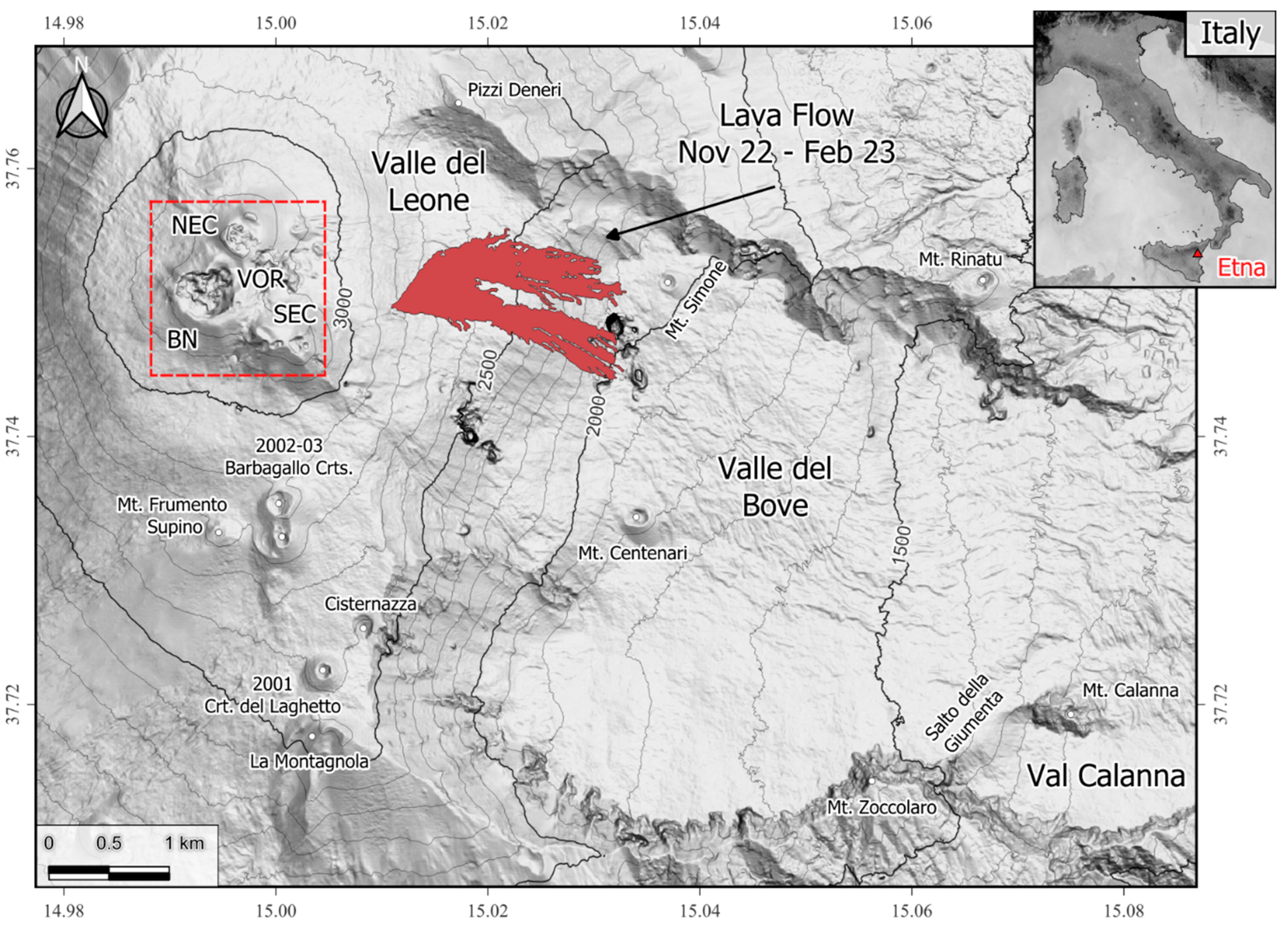
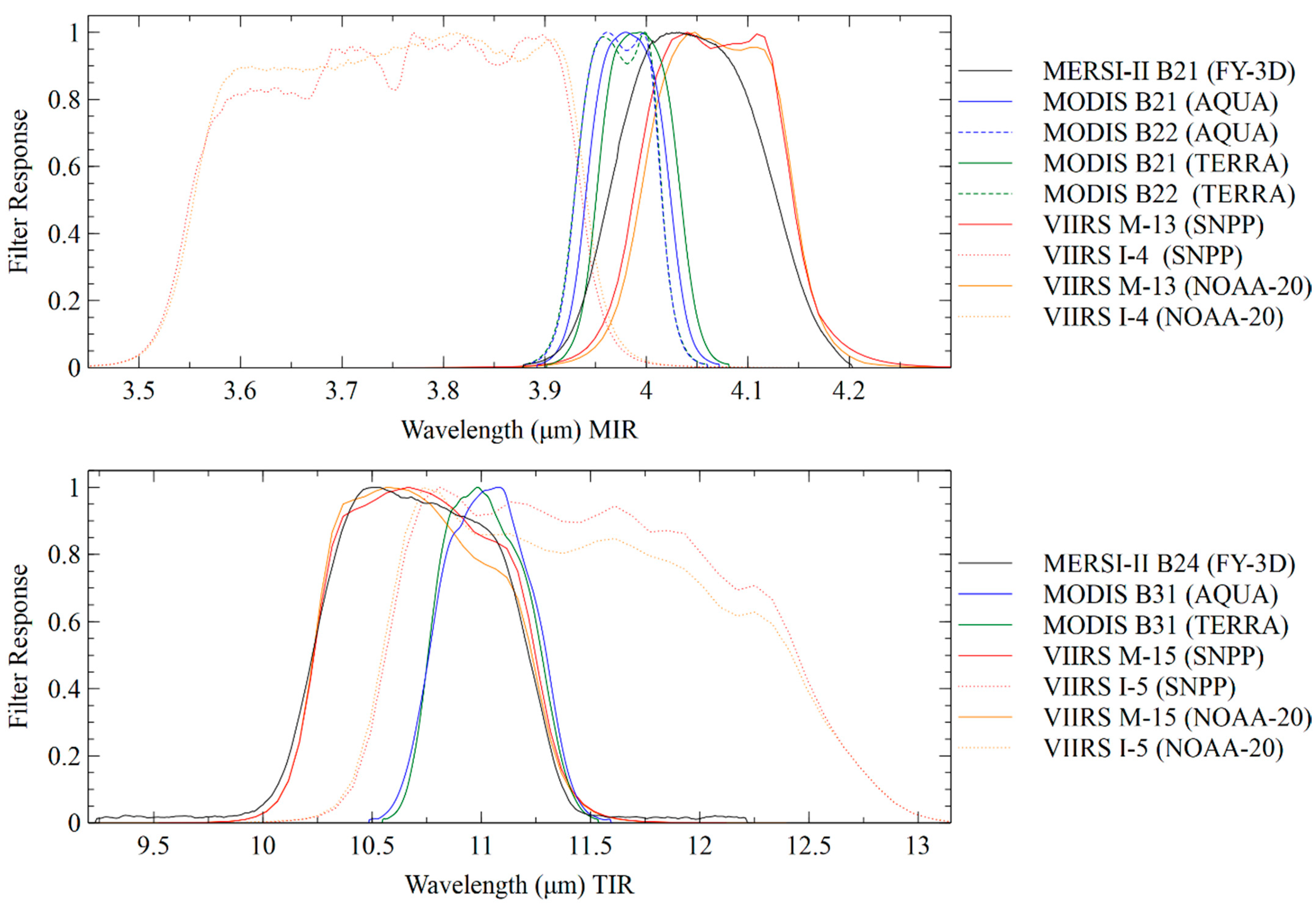

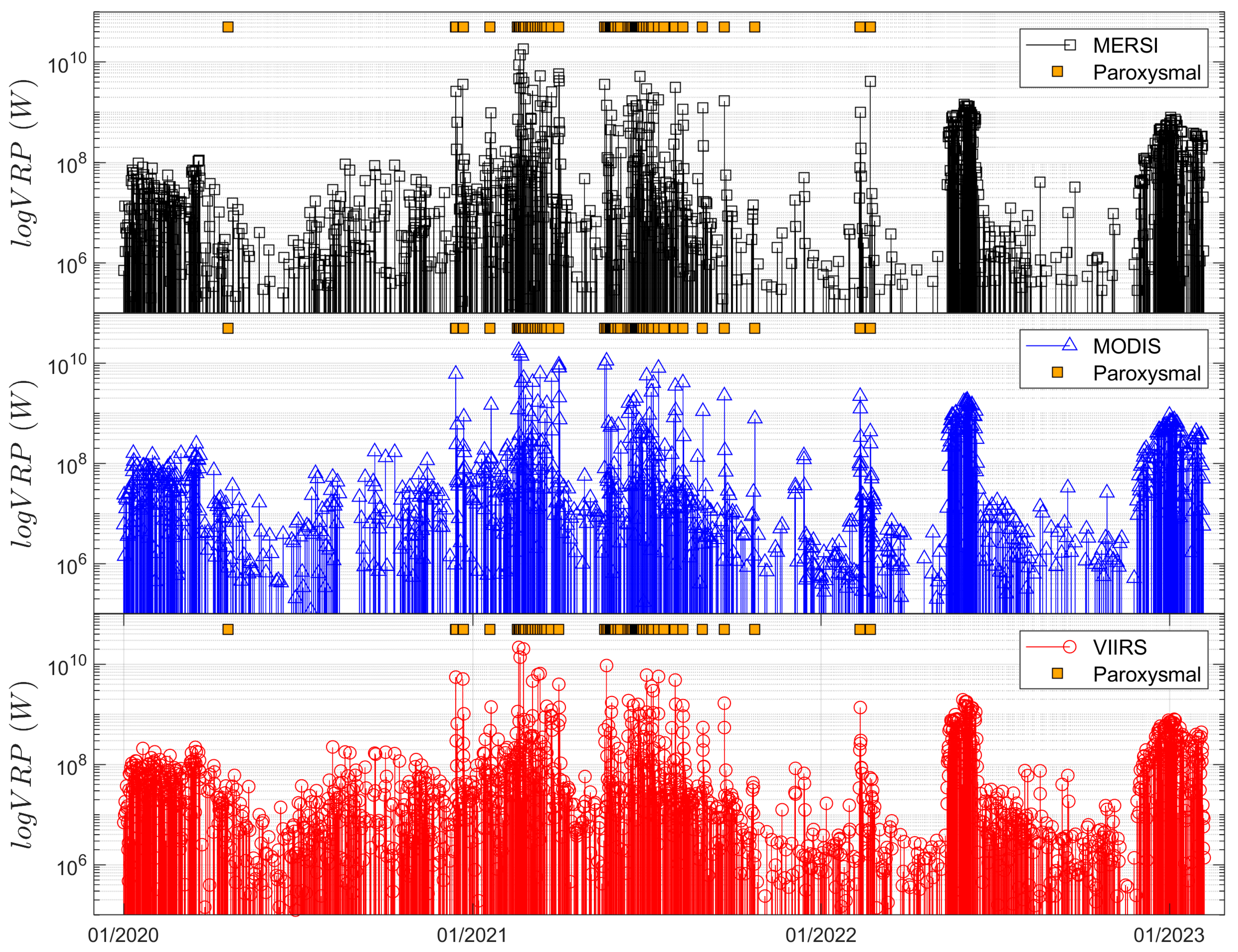
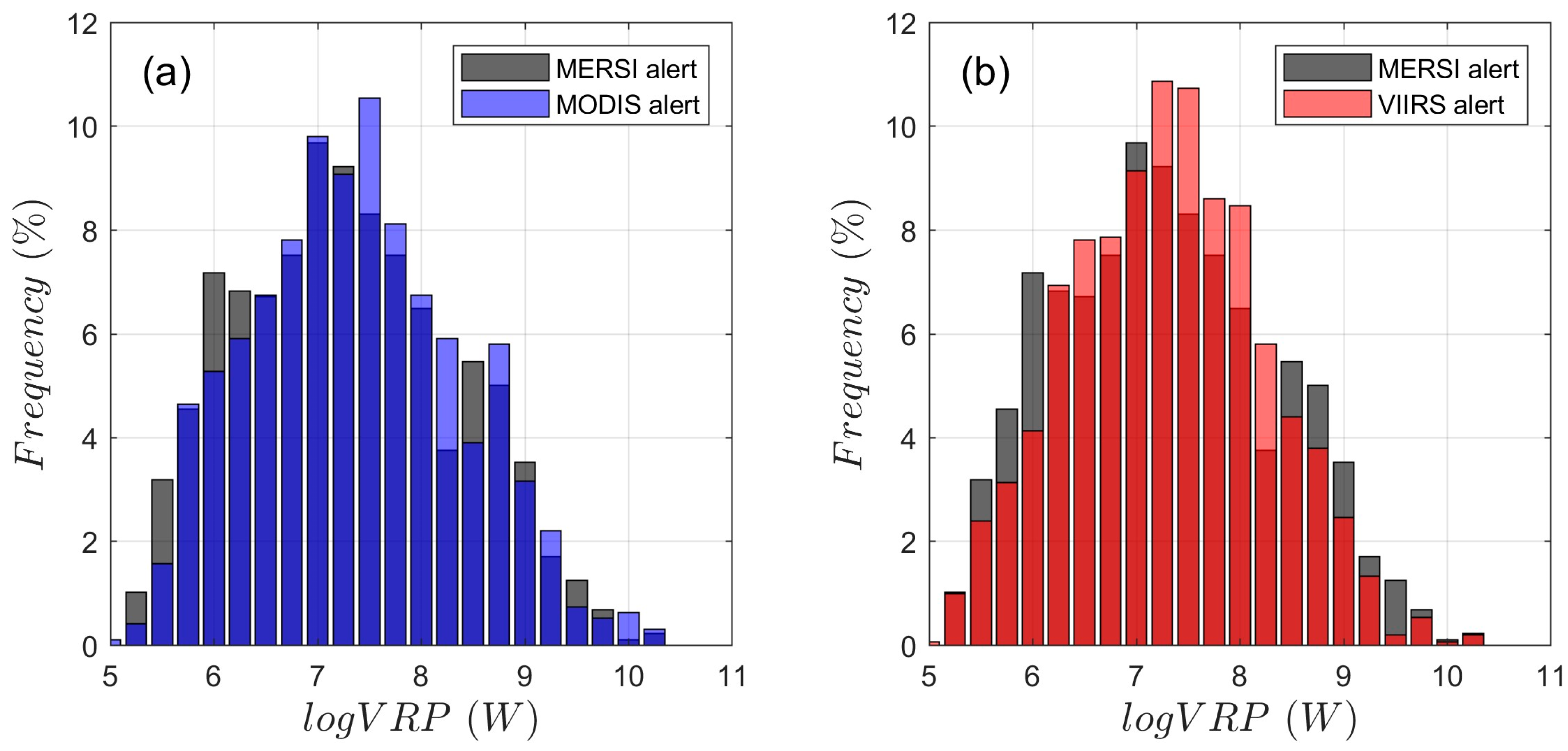
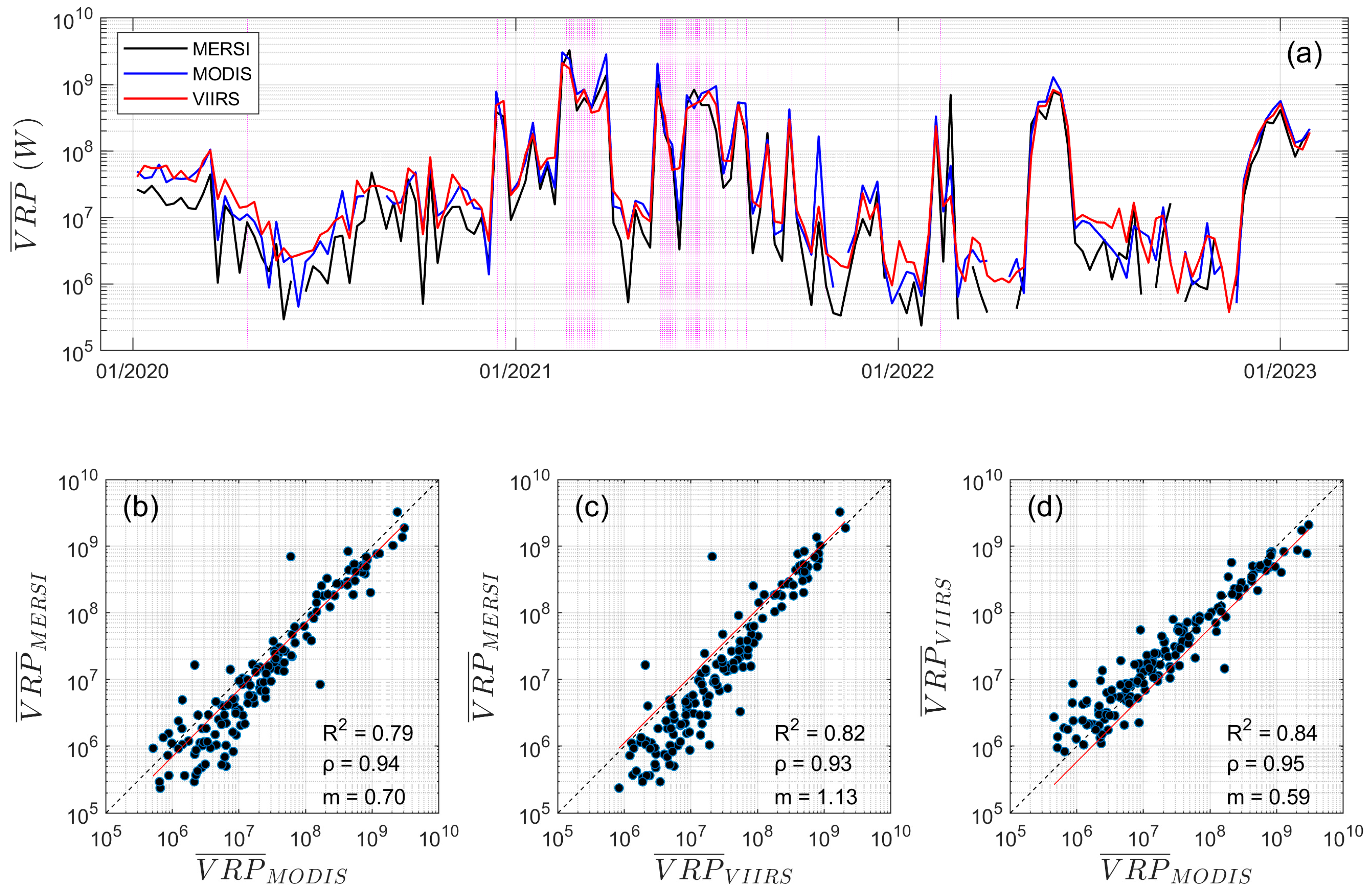
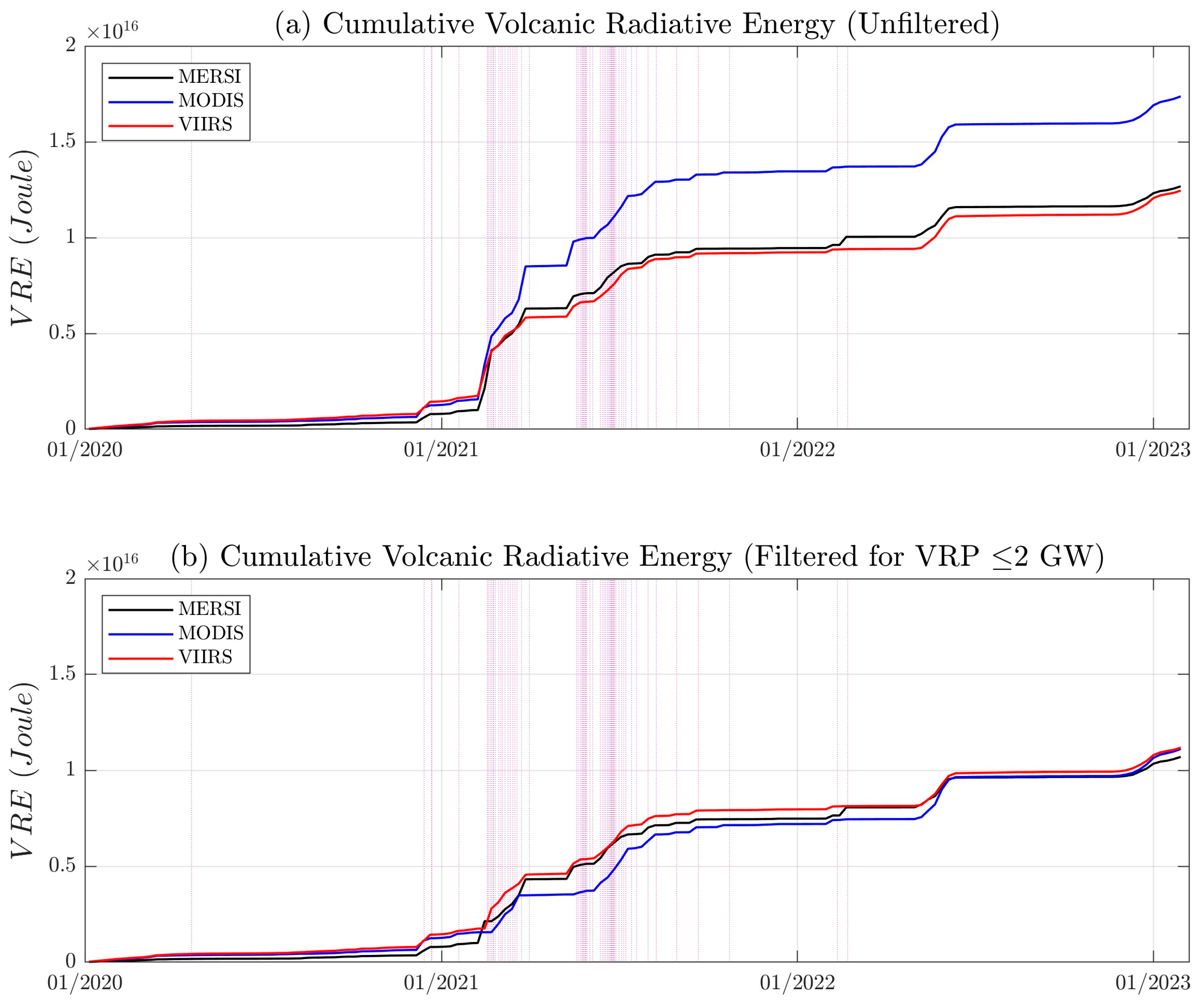
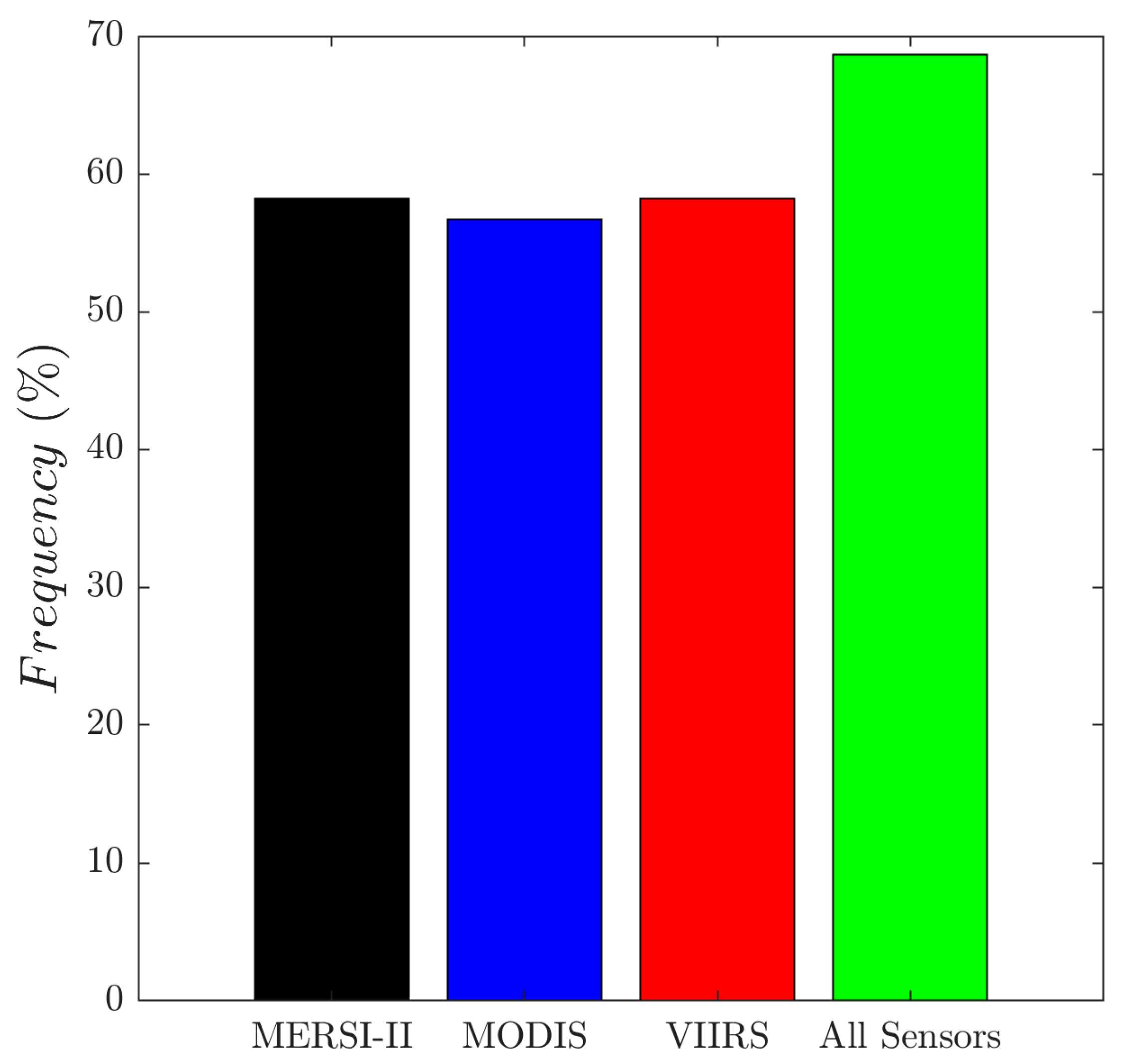
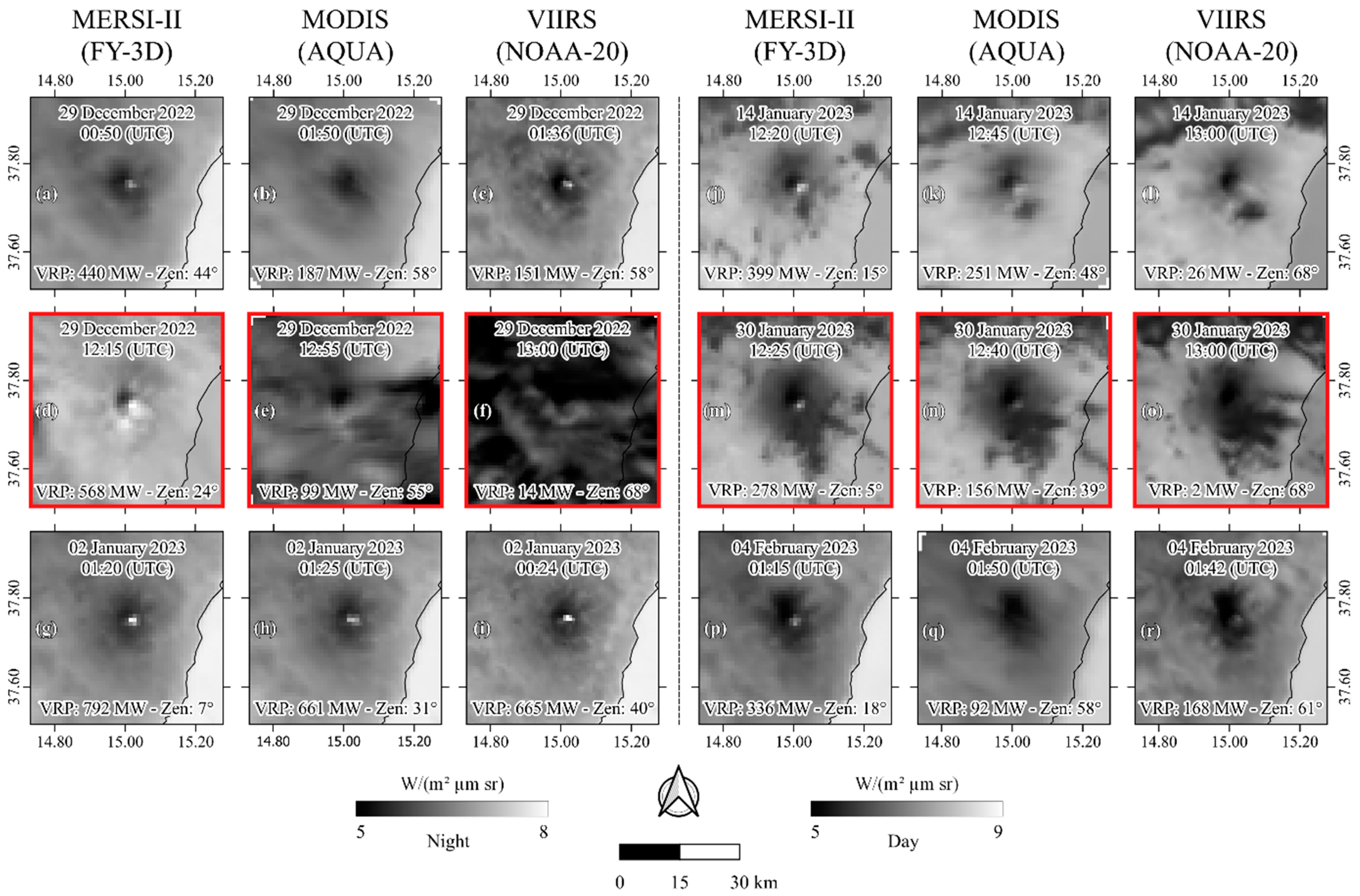
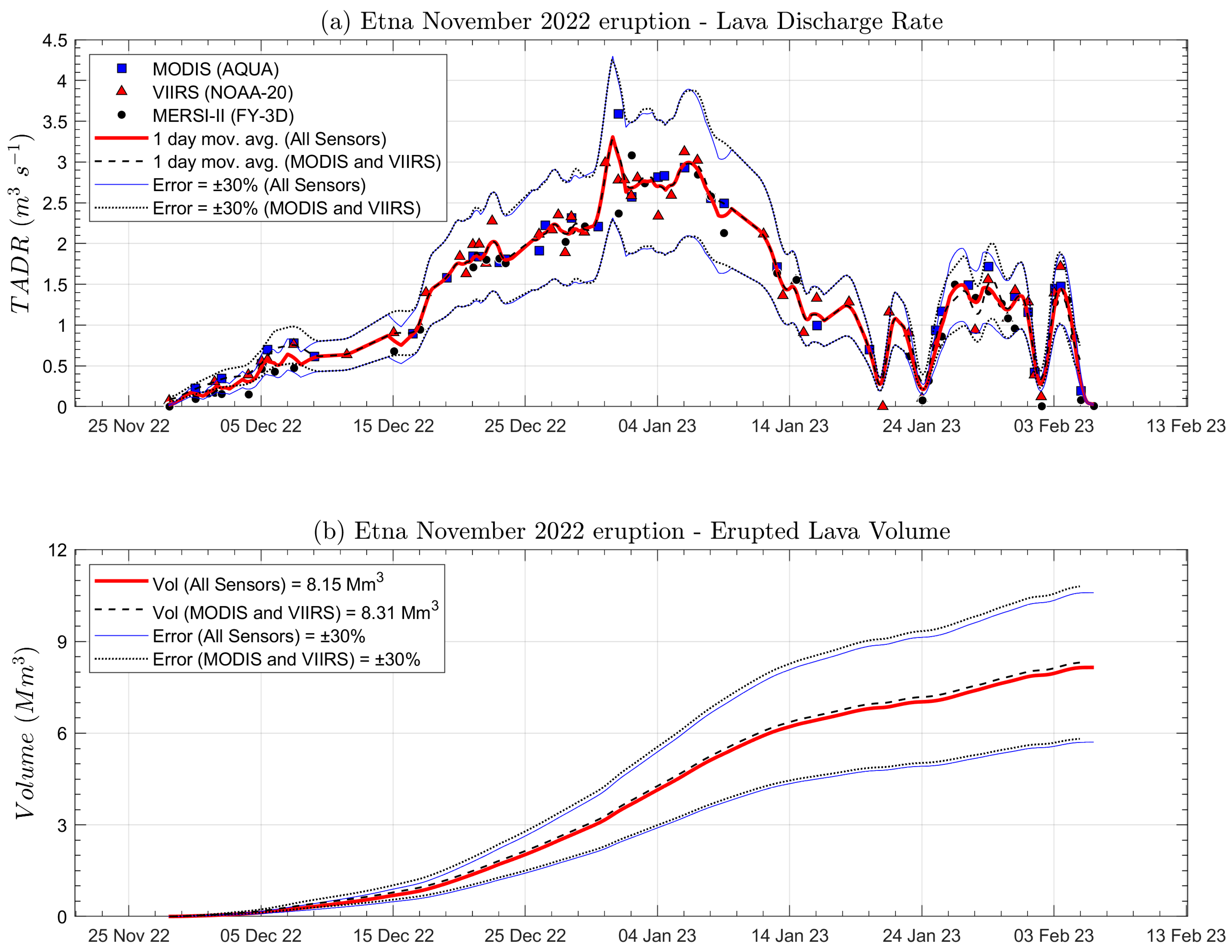
| MERSI-II (FY-3D) | MODIS (AQUA) | VIIRS (NOAA-20) | |
|---|---|---|---|
| Orbit altitude (km) | 836 | 705 | 824 |
| Equator Crossing time | 13:45 LT | 13:30 LT | 14:20 LT |
| Swath (km) | 2900 | 2330 | 3060 |
| Pixel resolution at nadir (km) | 1 | 1 | 0.75/0.375 |
| Pixel resolution at the edge (km) | >6 * | 4 | 1.5/0.75 |
| ID MIR Band (s) | 21 | 21/22 | M-13/I-4 |
| Spectral range (µm) | 3.973–4.128 | 3.929–3.989 | 3.973–4.128 |
| 3.940–4.001 | 3.550–3.930 | ||
| TMAX (SNR-NEΔT on orbit) | 380 K (0.25) | 500 K (0.183) | 634 K (0.04) |
| 331 K (0.019) | |||
| ID TIR Band (s) | 24 | 31 | M-15/I-5 |
| Spectral range (µm) | 10.300–11.300 | 10.780–11.280 | 10.263–11.263 |
| 10.500–12.400 | |||
| TMAX (SNR-NEΔT on orbit) | 330 K (0.4) | 400 K (0.017) | 343 K (0.03) |
| MERSI-II (FY-3D) | MODIS (AQUA) | VIIRS (NOAA-20) | |
|---|---|---|---|
| Total scenes | 3117 | 2690 | 3105 |
| Scenes with alerted pixels | 879 (28.20%) | 948 (35.24%) | 1501 (48.34%) |
| Scenes with zenith ≤ 40° | 1262 | 1176 | 1223 |
| Scenes with alerted pixels (zen. ≤ 40°) | 561 (44.45%) | 537 (45.66%) | 704 (57.56%) |
| Mean VRP (MW) | 253.69 | 306.07 | 192.22 |
| MAX VRP (MW) | 18126 | 18089 | 21748 |
| Date | Time F | Time M | Time V | MW (Zenith°) F | MW (Zenith°) M | MW (Zenith°) V | Δt F/M | Δt F/V | Δt M/V |
|---|---|---|---|---|---|---|---|---|---|
| 22 December 2022 | 01:20 | 01:45 | 00:30 | 463 (4) | 80 (56) | 452 (32) | −00:25 | +00:50 | +01:15 |
| 23 December 2022 | 01:00 | 00:50 | 00:12 | 467 (32) | 455 (27) | 240 (55) | +00:10 | +00:48 | +00:38 |
| 29 December 2022 * | 00:50 | 01:50 | 01:36 | 440 (44) | 187 (58) | 151 (58) | −01:00 | −00:46 | +00:14 |
| 29 December 2022 * | 12:15 | 12:55 | 13:00 | 568 (24) | 99 (55) | 14 (68) | −00:40 | −00:45 | −00:05 |
| 2 January 2023 * | 01:20 | 01:25 | 00:24 | 792 (7) | 661 (31) | 665 (40) | −00:05 | +00:56 | +01:01 |
| 3 January 2023 | 01:00 | 00:30 | 01:42 | 704 (35) | 669 (55) | 377 (61) | +00:30 | −00:42 | −01:12 |
| 8 January 2023 | 01:10 | 00:45 | 01:48 | 662 (24) | 657 (38) | 306 (65) | +00:25 | −00:38 | −01:03 |
| 12 January 2023 | 12:55 | 13:00 | 11:54 | 104 (41) | 8 (60) | 48 (2) | −00:05 | +01:01 | +01:06 |
| 14 January 2023 | 01:00 | 01:45 | 01:36 | 83 (37) | 34 (53) | 54 (58) | −00:45 | −00:36 | +00:09 |
| 14 January 2023 * | 12:20 | 12:45 | 13:00 | 399 (15) | 251 (48) | 26 (68) | −00:25 | −00:40 | −00:15 |
| 28 January 2023 | 01:40 | 01:50 | 00:36 | 343 (28) | 120 (57) | 241 (23) | −00:10 | +01:04 | +01:14 |
| 30 January 2023 | 01:05 | 01:35 | 01:36 | 324 (30) | 313 (44) | 129 (58) | −00:30 | −00:31 | −00:01 |
| 30 January 2023 * | 12:25 | 12:40 | 13:00 | 278 (5) | 156 (39) | 2 (68) | −00:15 | −00:35 | −00:20 |
| 4 February 2023 * | 01:15 | 01:50 | 01:42 | 336 (18) | 92 (58) | 168 (61) | −00:35 | −00:27 | +00:08 |
Disclaimer/Publisher’s Note: The statements, opinions and data contained in all publications are solely those of the individual author(s) and contributor(s) and not of MDPI and/or the editor(s). MDPI and/or the editor(s) disclaim responsibility for any injury to people or property resulting from any ideas, methods, instructions or products referred to in the content. |
© 2023 by the authors. Licensee MDPI, Basel, Switzerland. This article is an open access article distributed under the terms and conditions of the Creative Commons Attribution (CC BY) license (https://creativecommons.org/licenses/by/4.0/).
Share and Cite
Aveni, S.; Laiolo, M.; Campus, A.; Massimetti, F.; Coppola, D. The Capabilities of FY-3D/MERSI-II Sensor to Detect and Quantify Thermal Volcanic Activity: The 2020–2023 Mount Etna Case Study. Remote Sens. 2023, 15, 2528. https://doi.org/10.3390/rs15102528
Aveni S, Laiolo M, Campus A, Massimetti F, Coppola D. The Capabilities of FY-3D/MERSI-II Sensor to Detect and Quantify Thermal Volcanic Activity: The 2020–2023 Mount Etna Case Study. Remote Sensing. 2023; 15(10):2528. https://doi.org/10.3390/rs15102528
Chicago/Turabian StyleAveni, Simone, Marco Laiolo, Adele Campus, Francesco Massimetti, and Diego Coppola. 2023. "The Capabilities of FY-3D/MERSI-II Sensor to Detect and Quantify Thermal Volcanic Activity: The 2020–2023 Mount Etna Case Study" Remote Sensing 15, no. 10: 2528. https://doi.org/10.3390/rs15102528
APA StyleAveni, S., Laiolo, M., Campus, A., Massimetti, F., & Coppola, D. (2023). The Capabilities of FY-3D/MERSI-II Sensor to Detect and Quantify Thermal Volcanic Activity: The 2020–2023 Mount Etna Case Study. Remote Sensing, 15(10), 2528. https://doi.org/10.3390/rs15102528









